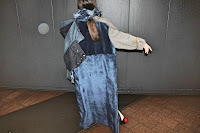I am very passionate about history, fine art and literature therefore the new brief of dissecting a chosen historical era and analysing the design details, textiles and pattern from arising inspiration is perfect for me.
As soon as the brief was mentioned the highway man came to mind. I believe this is because I have been watching and enjoying Canal Plus' 'Versailles', the ten episode period drama following Louis XIV.
Revolving my time bracket around famous highway man 'Claude Duval' I engaged in further extensive research. I found the famous french villain operated in England as opposed to his home country.
I am pleased then with my decision to study England during the late 17th Century rather than the famous and more commonly explored contemporaries across the channel. The era is called 'The English Restoration' and begins with King Charles II returning to his 'rightful' position as king after the austere, Puritan leadership of Oliver Cromwell and his son Richard Cromwell, the latter under whom a demise of leadership began. I love the decadence and opulence of the era. The court of the nation takes a sigh of relief after being released from the strict rules of Cromwell's leadership and head full throttle towards debauched and dandy lifestyles of drinking, sex and vanity. I have always been a lover of colour and this era rich colours return to fashion tenfold. I am an actor and vocalist with a love of the theatre and in this era Charles II, an admirer of performance, lifts all bans on players in the country setting up two court ensembles for his entertainment. The fascination with gods and goddesses at the time, demonstrated in portraiture, namely that of Peter Lely who would depict the 'celebrities' of the time, such as Catherine of Braganza, Nell Gwynn or Barbara Villiers in the roles such as Minerva, Venus or St Catherine, represents the courts obsession with power and beauty; immortality even.
Even for the lower classes, who of course did not share in the excess of the uppers, a newfound sense of independence emerged, where many had at least some disposable income for the first time in their family history. This was owed to new markets such as makeup flogging and portrait etching distribution. With a freer market and a return to the previously prohibited pastimes such as cockfighting and gambling even the poor could share some way in the return to royalist debauchery.
My visits to The Wallace Collection, The National Gallery, The National Portrait Gallery, The National Art Library and The Victoria and Albert Museum have succesfully broadened my knowledge of the era. I love to read into the historical details hearing how they would perfume their gloves with jasmine flower and frangipani or cake their faces with lead based products to cover their skin imperfections. I love to use the images in my presentation; one of my sketchbook pages includes jasmine flower imagery from contemporary paintings as well as modern photography.
Having discovered on previous projects how effective 'Frankenstein collages' are for developing unusual and creative silhouettes in a prolific and interesting manner, I chose to continue my usage of the design development method with this project.
Rough and playful sketching enable me to enter into the mood of the era. Fun scribbles evoke the frivolity and style of the times.
I have learnt to be much freer with my sketching style using techniques like cross hatching to explore tone and shade. I believe my work looks much more professional because of it my previous sketches looking tight and immature in comparison.
Moving forward I wish to elevate the design details I have chosen into a modern aesthetic suitable for a 21st century wearer. I may use simpler, modern silhouettes combined with specific details to achieve this. I wish to develop a key colour palette to stick to throughout the process and will endeavour to source suitable materials in the next few days.
















